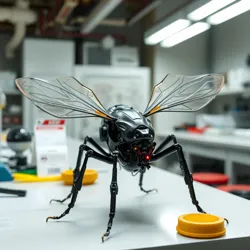Biomechanical Insect Design

Biomechanical Insect Design (BID) is a specialized field of synthetic biology that combines principles of mechanical engineering, robotics, and entomology to create artificial insects for various applications. This discipline emerged in the mid-22nd century as a response to the increasing need for precise, small-scale autonomous systems.
Core Principles
The foundation of BID rests on three primary principles:
-
Biomimetic Architecture: Designs closely follow natural insect anatomy while incorporating quantum-mechanical components for enhanced functionality.
-
Swarm Intelligence: Implementation of advanced hive-mind protocols allowing for coordinated action among multiple units.
-
Environmental Integration: Systems designed to coexist with natural ecosystems through adaptive camouflage technology.
Manufacturing Process
The creation of biomechanical insects involves several specialized steps:
Component Synthesis
Utilizing molecular assembly platforms, each insect's components are constructed at the nanoscale. The process employs quantum-forged materials that combine incredible strength with minimal weight.
Neural Integration
Each unit contains a synthetic neural core that manages both autonomous functions and swarm connectivity. These cores are programmed using quantum imprint technology.
Applications
Biomechanical insects serve numerous purposes:
- Industrial inspection and maintenance
- Environmental monitoring
- Targeted pollination programs
- Military reconnaissance
- Urban infrastructure maintenance
Current Developments
Recent advances in fusion micropowerplants have extended operational lifespans to over five years. The integration of self-replicating protocols has also enabled limited reproduction capabilities in controlled environments.
Challenges
Despite significant advances, the field faces several ongoing challenges:
- Power efficiency limitations
- Environmental impact concerns
- Integration with existing ecosystems
- Ethical considerations regarding autonomous capabilities
See Also
- Synthetic Swarm Intelligence
- Quantum Neural Networks
- Microscale Fusion Technology
References
- Journal of Synthetic Arthropod Design
- Biomechanical Engineering Standards
- Advanced Robotics Quarterly